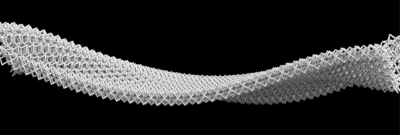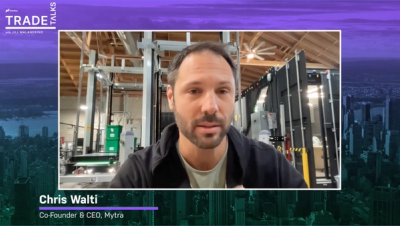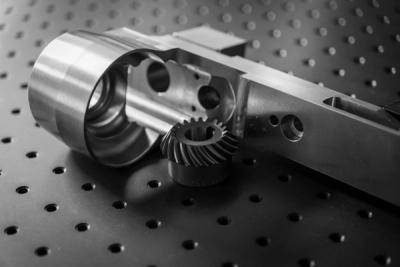Manufacturing and industry are at a crossroads. While technology has advanced at a rapid pace, many factories still operate using technology from a bygone era. These systems are mechanically defined, complex, and include thousands of points of possible failure.
They aren’t built to handle modern day pressures, such as geopolitical issues and unpredictable supply chains. Faced with uncertainty, manufacturers are struggling to find the balance between resilience and efficiency in their supply chain strategies. More redundancy and inventory are being added to cushion against disruption, but this comes at the expense of efficiency.
Add to that we see unprecedented increases in the cost to offshore manufacturing. Labor in China is 5x more expensive relative to US labor than it was 30 years ago, and shipping is 4x more expensive. Furthermore, we see 600k unfilled skilled manufacturing jobs today, growing to 2.1M by 2030, indicating the labor market is going from bad to worse in the US. with a lack of people who know how to work with complex systems. The pressure on the industrial base has never been higher.

We know exactly what that feels like. Our Mytra team has more than a half-century combined experience working in “manufacturing hell.” We’ve seen the best existing technology has to offer, and we’ve experienced its shortcomings. Taking a first principles approach, we’re building the most impactful system we could conceive to address the most common task in industry - material flow. 80% of the work in a warehouse and 40% of the work in a manufacturing facility is simply moving and storing material. We concluded that instead of solving moonshot robotics problems, focusing our firepower on the simplest and most extensible task was the right approach.
Today’s systems are incredibly complex, with thousands of different moving parts at the scale of an entire building. These create massive challenges for installing and commissioning - taking months to years. They also introduce thousands of single points of failure and technical debt requiring on-call highly specialized labor. Finally, these systems are extremely difficult to adjust making the initial design the one operators must make work for decades into the future. This often means fitting the business to the automation, which we believe is a critical flaw and must be addressed.
There are more than 1.3 million warehouse employees in the United States. While 15% of warehouses report some form of mechanization in the last decade, an estimated 95% of facilities have no meaningful automation for this highly repetitive task. For many employees, their day-to-day involves bending, reaching, and carrying heavy items – often racking up several miles over the course of a shift.

While warehouse jobs were once a guaranteed steady paycheck for blue collar workers, companies are struggling to keep up with the “great retirement.” Of those who left a manufacturing job, 82% cited retirement or health issues, according to a survey from the National Association of Manufacturers. Employers are also struggling to keep up with attrition. For every five people who retire, two new hires – if that – are made, according to another analysis. Driven by the desire for more schedule flexibility – a factor cited by 45% of workers as a reason for leaving their jobs – the younger generation is increasingly gravitating towards the gig economy. They are eager to work on their own terms, setting their schedules, determining their rates, and acting as their own bosses. This shift underscores the appeal of opportunities in the gig economy for those seeking greater control over their work lives. Economists agree that this shift in the labor market is the new normal, and underscores the need for solutions that don’t entirely rely on manual labor.
The pressures of meeting these internal challenges and operational demands are showing up in the macro data. Since 2011, there has been a decline in the rate of productivity in manufacturing in the United States, according to data analyzed by The Economist. 85% of GDP is tied to physical industries and, while GDP rose 4.9% annually in the third quarter of last year, manufacturing has failed to match the momentum of the broader economy. Services accounted for nearly 80% of output, while labor productivity in manufacturing contracted 0.2% year over year. The data is sending a clear message: the decades-old systems used by manufacturing and industry are misaligned with today’s needs.
How existing automation systems are missing the mark
Today’s factories need to be agile enough to handle fluctuating operating requirements and unpredictable needs. Existing automation systems aren’t equipped to meet these challenges. Instead, they are designed to perform specific, repetitive tasks, like packing parcels. This lack of reliable and intelligent automation that scales with business needs results in a misalignment between automation and consumer needs.
There’s a lot at stake. While traditional channels like television and print advertising have been used to predict purchasing behavior, social media sales are now a big part of the formula. Online shopping sales amounted to $6.3 trillion last year, and are expected to reach $8.1 trillion by 2026. And in a time when consumers can get goods and services on demand, the pressure to deliver their orders in a timely manner has never been greater – and can be make or break for whether or not brands earn a repeat customer. Nearly half of online shoppers worldwide said they expect to receive their orders within 24 hours. For a quarter of shoppers, getting their items within two hours is even more ideal. But squeezing returns out of those parcel packing robots isn’t a guarantee. Conditions have to be optimal before companies can even dream of seeing a marginal return.
Even still, over the last decade, a growing number of companies have invested in robots to help with basic tasks. For manufacturing employees globally, there is 1 robot for every 70 industrial workers, according to the International Federation of Robotics. While the use of robots has increased marginally every year, robots have several limitations that prevent them from scaling. They’re not only expensive, but they’re impractical to deploy at scale. Imagine the robot traffic jams that would happen if thousands of robots were deployed into the aisles of a facility. Robots also lack flexibility when business conditions change. As a result, operators are often left fitting the process to the automation, instead of having the freedom to design the best processes and having the automation fit that design.
In a world where so many external factors can affect a global network, companies need resilient local manufacturing and distribution solutions that enable them to meet customers’ needs. With new forces reshaping manufacturing and industry, the next solution has to tick several new boxes.
- It needs to use the fewest components possible, while covering the most applications possible.
- The technology must be something anyone can use without requiring advanced training or knowledge.
- The solution must be able to scale throughout the business without causing a disruption to existing production.
- And finally, it has to provide a compelling financial return that exceeds the status quo.
Powering productivity with a universal material flow system
For our universal material flow system to be a gamechanger across industries, we knew iterating on old systems wasn’t the answer. We had to start from a first principles approach.
Look at a photo of a warehouse or factory from 75 years ago. Much of the layout looks the same as it does today. There are items on tall racks, people, equipment, and aisles.

These aisles take up valuable space and only exist for only one reason – to give people and equipment access to items. Building the physics-limited optimized system allows for a much denser and more efficient structure that does away with aisles. The Mytra system uses a lattice structure that is inherently denser and stronger than a series of tall and skinny “planes on end,” which represent the common warehouse today. Instead of humans retrieving items from their stored locations the bots should do the work.
Our north stars in designing the system were:
- Identify physics-limited maximum level of kinematic flexibility at all payloads
- Achieve this in as few parts as possible
- Allow software to fully configure the system to address the needs of the operation at that moment. In other words, turn what is today a mechanical problem into a software problem.
To achieve the kinematic flexibility we knew we were going to need to build a 3D structure to support vertical movement. The simplest yet most robust structure in nature is a tessellating lattice structure.

With one simple “cell” one can replicate it like lego blocks to limitless sizes and shapes with minimal use of material.
Next, we needed a way to move material from any cell to any adjacent cell in full 3D. There is no system today that accomplishes this at any payload. Through simulation, we validated that 3-axis motion between adjacent cells yields the best performance because of its ability to massively parallelize bot movement to achieve both high throughput and density in a single system
In order to facilitate this movement, we created a bot that can move everything from lightweight items to entire pallets. Vertical propulsion – especially moving 3,000 pound pallets up and down – was our biggest challenge. Other heavy payload solutions solve this problem by using elevators or cranes, but these are installed in place, must be fixed in place, and are what most often bottleneck the system and break and limit pathways through the system. With each bot acting as its own elevator, our system provides the most kinematic flexibility possible. This affords us the luxury of focusing engineering firepower on optimizing this one robot for performance, cost, reliability, and serviceability. Our mechanical team considered every mechanism that would enable each bot to act as its own elevator, including cogs, sprockets, and linear motors. Nothing solved the parameters, so we developed a new system based on the worm gear. The helical drive is compact, highly levered, energy efficient, stable, and simple to manufacture.
Our radically simple mechanical design pushes the complexity into the software and removes the de facto customization that has held the industry back for decades. The software is configurable and can be used by everyone. Instead of seeing limitless choices on what buttons to press or what to do in a given situation, the software interface is radically simplified and displays only the information the operator needs in order to get the exact input the system needs from the operator. Our software is the glue that bonds the entire Mytra system. The result is a massive reduction in part count, part cost, and single points of failure, and an increase in optionality for how bots and material are stored and flow through the system. In the words of one industry expert - the system can “morph” instantly to address changing business needs and even entirely new applications.
It’s a huge improvement in performance and resiliency, especially over two dimensional autonomous mobile robots and existing shuttle and crane-based storage systems today.
Automation that increases margins
It’s critical that Mytra’s system delivers outstanding – not just marginal – returns to customers across a wide variety of applications and regions. Our simple system is uniquely designed to achieve this. We remove the sensors, motors, and other complex and expensive components typically fixed on the structure to the bot. In a typical system that might include 50,000 cells and 300 bots the result is dramatically fewer complex components reducing cost, effort to set up, and effort to maintain the system.
With the software, we can dynamically reconfigure the deployment to optimize for density, speed, and granular objectives, such as velocity of a specific SKU. This can all be done with zero downtime or disruption to ongoing operations.
Moving toward the future
The Mytra system we outlined today is only the beginning. We envision a future where the cells and bots of our universal material flow system are as ubiquitous in factories and warehouses as conveyor belts , racks, and forklifts have been in the last century. We want everyone to enjoy supercharged productivity and the most attractive returns they’ve ever seen – regardless of industry or region. There’s a place for people, too. Instead of physically grueling work, people can focus on tasks that require a human touch, like material manipulation and transformation.
We have an ambitious roadmap ahead of us and a skilled team ready to tackle every milestone. Our next step is to build an ecosystem of complementary technologies that enable total automation in warehouses and manufacturing facilities. As a company focused on software-facilitated material flow, we see areas to expand our software capabilities. In the future, Mytra will make software that can be applied to an entire network of buildings – not just the four walls. Automation also needs to be easy to use and adaptable to the constantly changing needs in manufacturing and industry.
This is a problem that is personal to us – and we’re going to solve it. There’s so much more work to do, and we can’t wait to show the world what we’re building at Mytra.
If you’re excited about supercharging industrial productivity, we’d love to hear from you! Visit our careers page to learn about current roles we’re hiring for, or send us an email to [email protected].



